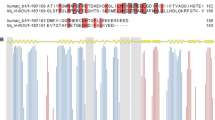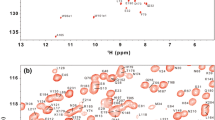Abstract
Soluble guanylate cyclase (sGC) enzyme is activated by the gaseous signaling agent nitric oxide (NO) and triggers the conversion of GTP (guanosine 5′-triphosphate) to cGMP (cyclic guanylyl monophosphate). It contains the heme binding H-NOX (heme-nitric oxide/oxygen binding) domain which serves as the sensor of NO and it is highly conserved across eukaryotes and bacteria as well. Many research studies focus on the synthesis of chemical compounds bearing possible therapeutic action, which mimic the heme moiety and activate the sGC enzyme. In this study, we report a preliminary solution NMR (Nuclear Magnetic Resonance) study of the H-NOX domain from Nostoc sp. cyanobacterium in complex with the chemical sGC activator cinaciguat (BAY58-2667). An almost complete sequence-specific assignment of its 1H, 15N and 13C resonances was obtained and its secondary structure predicted by TALOS+.


Similar content being viewed by others
Data availability
Assignment deposited in BMRB with ID: 28,118.
Change history
05 January 2021
A Correction to this paper has been published: https://doi.org/10.1007/s12104-020-09991-2
References
Alexandropoulos II, Argyriou AI, Marousis KD, Topouzis S, Papapetropoulos A, Spyroulias GA (2016) 1H, 13C, 15N backbone and side-chain resonance assignment of Nostoc sp. C139A variant of the heme–nitric oxide/oxygen binding (H-NOX) domain. Biomol NMR Assign 10:395–400
Breitenstein S, Roessig L, Sandner P, Lewis KS (2016) Novel sGC stimulators and sGC activators for the treatment of heart failure. Heart failure. Springer, Cham, pp 225–247
Dawson NL et al (2017) CATH: an expanded resource to predict protein function through structure and sequence. Nucleic Acids Res 45:D289–D295
Erdmann E, Semigran MJ, Nieminen MS, Gheorghiade M, Agrawal R, Mitrovic V, Mebazaa A (2013) Cinaciguat, a soluble guanylate cyclase activator, unloads the heart but also causes hypotension in acute decompensated heart failure. Eur Heart J 34:57–67
Evgenov OV, Pacher P, Schmidt PM, Haskó G, Schmidt HH, Stasch J-P (2006) NO-independent stimulators and activators of soluble guanylate cyclase: discovery and therapeutic potential. Nat Rev Drug Discov 5:755–768
Follmann M et al (2013) The chemistry and biology of soluble guanylate cyclase stimulators and activators Angewandte. Chem Int Ed 52:9442–9462
Friebe A, Mergia E, Dangel O, Lange A, Koesling D (2007) Fatal gastrointestinal obstruction and hypertension in mice lacking nitric oxide-sensitive guanylyl cyclase. Proc Nat Acad Sci 104:7699–7704
Gheorghiade M et al (2013) Soluble guanylate cyclase: a potential therapeutic target for heart failure. Heart Fail Rev 18:123–134
Grimminger F et al (2009) First acute haemodynamic study of soluble guanylate cyclase stimulator riociguat in pulmonary hypertension. Eur Respir J 33:785–792
Keller RL (2004) CANTINA VERLAG. The computer aided resonance assignment tutorial. 1st edn
Ma X, Sayed N, Beuve A, Van Den Akker F (2007) NO and CO differentially activate soluble guanylyl cyclase via a heme pivot-bend mechanism. EMBO J 26:578–588
Makrynitsa GI, Zompra AA, Argyriou AI, Spyroulias GA, Topouzis S (2019) Therapeutic targeting of the soluble guanylate cyclase. Curr Med Chem 26:2730–2747
Martin F et al (2010) Structure of cinaciguat (BAY 58–2667) bound to Nostoc H-NOX domain reveals insights into heme-mimetic activation of the soluble guanylyl cyclase. J Biol Chem 285:22651–22657
Nossaman B, Pankey E, Kadowitz P (2012) Stimulators and activators of soluble guanylate cyclase: review and potential therapeutic indications. Crit Care Res Pract. https://doi.org/10.1155/2012/290805
Schubert M, Labudde D, Oschkinat H, Schmieder P (2002) A software tool for the prediction of Xaa-Pro peptide bond conformations in proteins based on 13 C chemical shift statistics. J Biomol NMR 24:149–154
Shen Y, Delaglio F, Cornilescu G, Bax A (2009) TALOS+: a hybrid method for predicting protein backbone torsion angles from NMR chemical shifts. J Biomol NMR 44:213–223
Underbakke ES, Iavarone AT, Chalmers MJ, Pascal BD, Novick S, Griffin PR, Marletta MA (2014) Nitric oxide-induced conformational changes in soluble guanylate cyclase. Structure 22:602–611
Wüthrich K (1986) NMR with proteins and nucleic acids. Europhys News 17:11–13
Author information
Authors and Affiliations
Contributions
Garyfallia I. Makrynitsa and Aikaterini I. Argyriou have equally contributed to this work.
Corresponding author
Ethics declarations
Conflict of interest
The authors declare no competing financial interest.
Additional information
Publisher’s Note
Springer Nature remains neutral with regard to jurisdictional claims in published maps and institutional affiliations.
Rights and permissions
About this article
Cite this article
Makrynitsa, G.I., Argyriou, A.I., Dalkas, G. et al. Backbone and side chain NMR assignments of the H-NOX domain from Nostoc sp. in complex with BAY58-2667 (cinaciguat). Biomol NMR Assign 15, 53–57 (2021). https://doi.org/10.1007/s12104-020-09982-3
Received:
Accepted:
Published:
Issue Date:
DOI: https://doi.org/10.1007/s12104-020-09982-3




